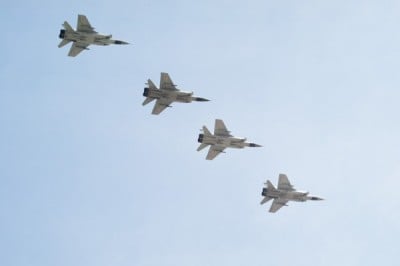The Performance of Russia’s Aerospace Forces in Syria, … “Took NATO by Surprise”

If the Russian Aerospace Forces’ performance took NATO by surprise, it is because earlier Russian operations did not suggest that level of ability. Russian aviation took serious losses in the 2008 conflict with Georgia: 7 aircraft shot down including a Tu-22M bomber, 4 damaged, or one loss per each 17 combat missions. There was practically no new aircraft procurement since 1994. Russian aircrews flew far fewer hours than their NATO counterparts.
But the Georgia conflict served as a wake-up call and led to reforms which proved both crucial and successful.
Russian airpower was reduced in numbers, and reorganized into 8 air bases, each supporting several air groups based on individual airfields, which allowed individual pilots to get more flying time. In 2012, the air bases and air groups were renamed divisions and regiments.
Starting with 2012, new and modernized aircraft began to enter service in large numbers. By 2014 and 2015, Russian air forces were receiving 100 new or thoroughly modernized aircraft a year, and that pace is expected to continue in 2016. By 2020, the Russian Aerospace Forces (VKS) are expected to have at their disposal about 1500 mostly modern combat aircraft, including 130 heavy bombers such as the Tu-160, Tu-95MS, and Tu-22M, over 800 fighters, and over 500 tactical bombers and attack aircraft.
These reforms led to the Russian VKS demonstrating a number of capabilities which seemed beyond its reach only seven years earlier:
- The ability to deploy and sustain a force of 100 combat aircraft for several months in difficult conditions, and the ability to sustain a high rate of combat missions.
- The ability to function in a “reconnaissance-strike complex” mode, which enables intelligence data obtained by a variety of sources, including aircraft, satellites, drones, and agents, to be converted into targeting data to allow even mobile targets, such as enemy mobile troop or supply columns to be quickly targeted.
- The ability to conduct close air support as well as battlefield interdiction and suppression against an enemy practiced in concealment.
- The ability to operate in any weather conditions, at any time of day.
- The ability to use precision-guided munitions.
- The ability to integrate long-range aerial early warning aircraft such as the A-50 and intelligence and ground surveillance aircraft, such as the Il-20 and Tu-214R, into the overall concept of operations.
- The ability to use drones on a large scale and as part of an integrated aerial operation.
- Granted, the picture is not perfect. Here is what Russian airpower has not demonstrated in Syria:
- The ability to organize and operate large aerial “strike packages” against sophisticated aerial and anti-aircraft defenses. To be sure, while US and some NATO forces may have had that ability a decade ago, it has been degraded by NATO airpower being used in Afghanistan and Iraq.
- The ability to use large numbers or a large variety of precision-guided munitions. Russian aircraft did use many satellite-guided KAB-500R bombs and Kh-29L laser-guided missiles. But most of the munitions dropped were unguided bombs and aerial rockets, aided by sophisticated on-board digital ballistic computers which allowed them to strike their targets with a fair degree of accuracy. Russia does not have tactical stand-off munitions like the SDB or AASM or the JASSM tactical cruise missile. Such weapons are in development and have been shown at MAKS-2015, but they will not be in service for years. On the other hand, perhaps there is a silver lining in this, because Russia is not over-reliant on satellite navigation systems to the same extent as NATO which might well experience a shock once it tries to use such weapons against opponents more sophisticated than the Taliban.
The maturity of some of the most modern aerial systems which entered service only very recently. The Su-30SM, Su-35S and Su-34 do appear to have at least minimum operational capabilities, as their performance in Syria did not give reason to doubt their performance. At the same time, the conflict did not push them to the edge of their performance, as most of the missions were performed equally well but much older though upgraded Su-24 bombers. Russian aircraft in Syria did not include the Mi-28N or Ka-52 attack helicopters, which raises questions about the degree of their operational maturity. However, nothing suggests these aircraft are failures in the same sense as the F-35, for example.
Everything suggests that the Russian VKS will not rest on their laurels but instead will continue to build on their strengths and eliminate weaknesses, so that it will be an even more capable force in the next conflict it has to fight.
If you’re able, and if you like our content and approach, please support the project. Our work wouldn’t be possible without your help: PayPal: [email protected] or via: http://southfront.org/donate/ or via:https://www.patreon.com/southfront
Subscribe our channel!: https://www.youtube.com/channel/UCaV1…
Visit us: http://southfront.org/

